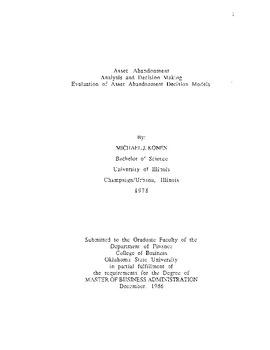| dc.contributor.author | Konen, Michael John | |
| dc.date.accessioned | 2015-09-29T19:58:41Z | |
| dc.date.available | 2015-09-29T19:58:41Z | |
| dc.date.issued | 1986-12 | |
| dc.identifier.uri | https://hdl.handle.net/11244/19248 | |
| dc.description.abstract | Scope and Method of Study: Abandonment is something that happens everyday within companies and with consumers. Nearly every person has decided to throw something away at one point in their life. Businesses make similar decisions every day. Sometimes the decisions are made voluntarily by the companies. Market and economic conditions frequently change. These changes require that projects and assets be reviewed periodically with respect to current and future profitability. Those assets (or projects) whose future profitability is questioned become candidates for possible abandonment. Many times certain projects only remain profitable when interest rates are low, or energy costs high, or tax laws favor investment. When their direction changes, the wise manager must make the decision that continues to enhance the profits of the firm. | |
| dc.description.abstract | This paper will review the types of models presented for use in making abandonment decisions and how these apply to the abandonment of physical assets. Two new models will be developed to assist the manager in making these abandonment decisions. Analysis will include reviewing the important variables and assessing the relative weight of each. | |
| dc.description.abstract | Findings and Conclusions: The models developed provide an enhancement to those found in the literature. The two new models proposed are contrasted with a model presented by another author. In the particular example, circumstances occur where the published model does not indicate abandonment and the new models do. It is these borderline cases where the use of the proper model can make a big difference in a go/no go decision. | |
| dc.description.abstract | It is the very fact that these things do change that causes us to not only evaluate the future cash flows and abandonment value but also make the decision whether or not to abandon the asset or keep it. It is hoped that this paper provides the analyst with a tool to evaluate the question and make the proper decision. | |
| dc.format | application/pdf | |
| dc.language | en_US | |
| dc.rights | Copyright is held by the author who has granted the Oklahoma State University Library the non-exclusive right to share this material in its institutional repository. Contact Digital Library Services at lib-dls@okstate.edu or 405-744-9161 for the permission policy on the use, reproduction or distribution of this material. | |
| dc.title | Asset abandonment analysis and decision making evaluation of asset abandonment decision models | |
| osu.filename | Thesis-1986R-K82a.pdf | |
| osu.accesstype | Open Access | |
| dc.type.genre | Master's Report | |
| dc.type.material | Text | |
| thesis.degree.discipline | Business Administration | |
| thesis.degree.grantor | Oklahoma State University | |
